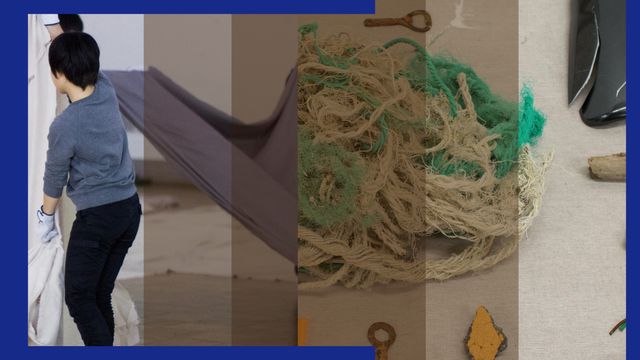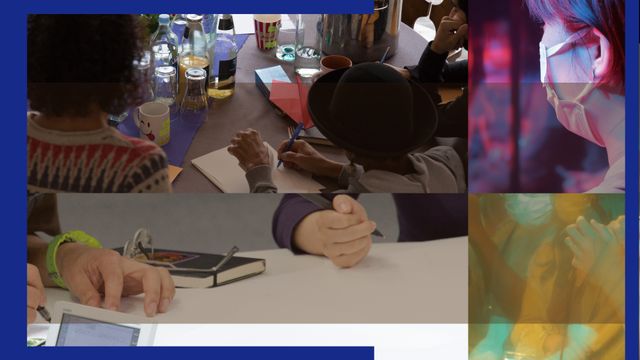How to live together sustainably
An interview with Koki Tanaka

Koki Tanaka used the guiding questions of Where is the Planetary? to design five experimental settings for the participants to develop perspectives and practices that consider and bring together not only the systemic processes of planet Earth, but also the worldviews of its inhabitants. In a conversation he explains this approach.
How do you approach modes of togetherness and collaboration in your artistic practice?
In my practice, I gather people with a specific skill – pianists or potters, for instance – and, in search of a utopian moment of collaboration, we make something together. Or, we explore collective knowledge regarding how to live together as citizens in temporal gatherings under the predicament of the recent refugee crisis. The idea of togetherness sounds very positive, but it brings out the complexities of human existence. To be with someone is to step outside of convention and throw oneself into the process of negotiating with others or with an unknown situation. Being together is full of impossibilities. Most of the time, we are either hostile to or accustomed to each other. I always wonder: Is it possible to maintain a critical distance from someone and still be open to them? Our potential might lie somewhere between close friendship and antagonism.
The Planetary means encouraging humans to face the uncertainty of our existence and our future.
How do you conceive of the link between the micro-level of the group dynamics you explore in your practice and the vast concept of the planetary at stake in this project?
I think these are aspects of the same thing being looked at from different angles. This world is constructed through the accumulation of entities made up of small groups. And we call it friends, couples, family, community, society, nation-state, et cetera. A huge assembly of such concreteness, of course, includes nonhuman creatures, like cats, or everyday objects. Rather, people tend to think a cat is a part of their family – including me – and can be very attached to collectible objects, like stones. We can say that the whole of the configuration of all those entities is the planetary; it’s merely a difference in where our focus is. Society at a micro level is interconnected with the planetary, so my practice can become one of the elements in such a configuration. As a whole, this is to support the perspective of the planetary scale.

What are the elements (spatial, social, institutional, et cetera) that shape or define specific modes of togetherness and collaboration?
I use the format of a workshop of everyday activities to build a space for gatherings and collaboration. And the rolling-film camera can act as a device to make one’s actions conscious. As an artist, in designing the overall structure of Where is the Planetary? as a live event, I use both workshop and filming to generate the complex situation of human activities.
What does the medium of film mean to you? What can it bring forth in people – participants, filmmaker, and (later) the audience?
That my gatherings are also film sets adds an extra layer to the live event. It’s a tool for participants, a springboard. The presence of cameras makes us aware that our actions are being recorded. Usually, we are not that conscious of our presence. The camera makes us very aware of what we say, what we do, and even what we are. Not only the participants, facilitators, and audience, but also the film crew, HKW staff, and myself; we all become very aware of our presence. With this awareness, everyone there can break out of their daily routines. I hope for it to open up opportunities to speak about what could not be spoken of before, see what could not be seen, and, eventually, make us collectively aware of uncertainty.
Our potential might lie somewhere between close friendship and antagonism.
In regard to the the moving picture format, my thinking is this: All moving images can be considered documents of human activities – cinemas, YouTube, smartphones, et cetera. Nonhuman (or alien) archaeologists or anthropologists in the future might find what remains, even if only fragments, of this vast stock of moving images after humans are gone. It’s proof of the existence of human beings in the past – our presence. I imagine that this film document of the live events at HKW could eventually become one of the future archives of human activities.
In past works, you have dealt with the situation in Japan after the tsunami and the nuclear disaster of 2011 and how Japanese society processed this series of events. What do you see as the potential role art can play in dealing with natural disasters and risks as they increase due to climate change?
In the first instance, art cannot solve problems, because the function of art is to defunctionalize things. A museum is a place to display paintings or sculptures taken from, say, the religious context as a result of this defunctionalization. I don’t see it as a negative process. In the very beginning of a post-disaster society, art is useless. Society needs people to help and support it. But later on, when everyday life returns to a semblance of normal, art might be needed. I remember people getting stuck in a certain mindset in Japan: there were those who could legitimately speak about the disaster and those who could not. And then those perceived as not legitimized to comment would be attacked on social networking services. People became divided. Meanwhile, the experience of the disaster was fading away, and nuclear power plants began reactivation. Then right-wing politics emerge, racism rises, and post-disaster society falls apart. In such a situation art can arrive at the right moment to open up in-between spaces, to engage people with different opinions, and finally to recover a sense of caring for one another.

What does the planetary mean to you?
Most of my projects have focused on group dynamics among people. I have not engaged as much with planetary perspectives on human existence – such as the post-human or regarding collaboration between humans and nonhumans – but this is the lens through which I interpret the “planetary thinking” advocated in Where is the Planetary? I thought of it as an act of unraveling the parameters of our customary thinking. Having our eyes wide open to the planet (or “the world”) and human existence. The situation of togetherness that most of my practice circles around can be a place to re-examine human activities and rethink human relations. In this sense, the planetary, for me, means encouraging humans to face the uncertainty of our existence and our future.